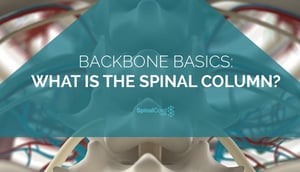Backbone Basics: What is the Spinal Column?
The spinal column is made up of 33 bones (called vertebrae) stacked on top of one another. It provides the base support for your entire body and allows you to stand, bend, and twist without causing harm to the spinal cord. The spinal column is made up of 4 different regions:
The spinal column is made up of 4 different regions:
- the cervical region (neck)
- the thoracic region (chest)
- the lumbar region (lower back)
- the sacral region (pelvic)
In addition to these: the curves, muscles, intervertebral discs, facet joints, ligaments, spinal cord, and spinal nerves aid the spinal column in providing all the elements needed for the spine to support itself. Each part plays a key role in the function and health of the spine, and any of these parts can be affected by strain, injury, and/or disease.
The Cervical Spine
The cervical spine is made up of 7 vertebrae that are labeled: C1, C2, C3, C4, C5, C6 & C7. These vertebrae start at the bottom of the skull and continue down until they reach the thoracic spine. This part of the spine has cylindrical bones located in front of the spinal cord which stack up to make a column forming the neck. It works with muscles, tendons, ligaments, and joints to provides support, structure, and flexibility to the spine.
Here are a few things to know about the cervical spine:
Vertebrae C1 & C2 are at the top of the neck:
- C1 (the atlas) is shaped like a ring. It connects to the occipital bone to support the base of the skull, forming the atlanto-occipital joint. Around 50% of the head's range of motion depends on this joint.
- C2 (the axis) fits inside the atlas and the axis rotates around it to form the atlantoaxial point.
Vertebrae C3-C6 are known as typical vertebrae because they all are made up of the same basic characteristics throughout the spine.
These characteristics include:
- The vertebral body: These are cylindrically-shaped and located at the front of the bony vertebra. It is what protects the vertebra from any excess shock that the cushiony discs could not absorb.
- The vertebral arch: This arch is made up of 2 pedicles and 2 laminae located in the rear of the vertebra and wraps around the spinal cord.
- Face joints: located between each pedicle and lamina, they are coated with cartilage to allow movement between vertebrae.
Vertebrae C7 is considered unique because its role is the most prominent:
Sticking out further than any other bones in the neck, it is located at the bottom and connects with the top of the thoracic spine.
The Thoracic Spine
The thoracic spine is the region consisting of the upper back and abdomen. It sits right in between the cervical and lumbar regions. The muscles that support the thoracic spine’s ability are:
- Spinalis: moves along the spine and helps with posture and
- Longissimus: travels up the spine from the middle of the lumbar spine and runs on both sides of the spinalis.
The thoracic spine is made up of a pair of rib bones extending from the spaces between it’s 12 vertebrae. These rib bones protect many vital organs, such as the heart and the lungs.
The Lumbar Spine and The Sacrum
The lumbar vertebrae consists of 5 cylindrical bones that make up the lower back. These bones carry all of the upper body’s weight along with flexibility in the trunk region. The lumbar vertebrae are stacked to form a column that makes up the c-shaped concave lumbar curve in the lower back. This region has the largest diameter around compared to the thoracic and cervical vertebrae. It sits right on top of the sacrum, which is also formed by 5 vertebrae.
- the first 3 vertebrae in the sacrum are me up of wide wing-like projections called alae
- the sacrum forms the back wall of the pelvis and joints at the hip bone called the sacroiliac joints.
- the sacral canal runs down the center of the sacrum, representing the end of the vertebral canal
Spinal Column Injuries
If one is injured in their spine, the effects of the injury will depend on which part of the spinal column was damaged and if the nerves were harmed. If injuries occur in the cervical region of the spine, breathing issues may occur as well as partial or complete paralysis of most of the body's extremities.
With the thoracic nerves, an injury can cause paraplegia and may result in troubles controlling the bowels and bladder. Injuries involving the lumbar and sacral nerves can cause dysfunction in the hips and legs as well as the bowels and bladder.
If you have experienced a spinal cord injury, it may seem like your life has been forever changed. Scientists are hopeful and have been discovering groundbreaking technology that could someday provide enough information on how to repair spinal cord injuries.
There are many treatments and rehabilitation programs available that provide people with spinal cord injuries the ability to lead independent and fruitful lives.
Stay Updated on Advancements On Traumatic Brain &
Spinal Cord Injuries
About the Author





